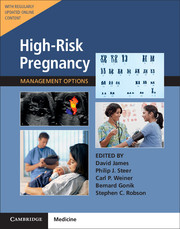Book contents
- Frontmatter
- Contents
- List of Contributors
- Preface
- Section 1 Prepregnancy Problems
- Section 2 Early Prenatal Problems
- Section 3 Late Prenatal – Fetal Problems
- Section 4 Problems Associated with Infection
- Section 5 Late Pregnancy – Maternal Problems
- 30 Substance Misuse in Pregnancy
- 31 Medication in Pregnancy
- 32 Hypertension in Pregnancy
- 33 Cardiac Disease in Pregnancy
- 34 Respiratory Disease in Pregnancy
- 35 Anemia and White Blood Cell Disorders in Pregnancy
- 36 Hematological Malignancies in Pregnancy
- 37 Thrombocytopenia and Bleeding Disorders in Pregnancy
- 38 Disorders of Coagulation in Pregnancy
- 39 Autoimmune Disease in Pregnancy
- 40 Diabetes in Pregnancy
- 41 Thyroid Disease in Pregnancy
- 42 Pituitary and Adrenal Disease in Pregnancy
- 43 Gastrointestinal and Liver Diseases in Pregnancy
- 44 Neurologic Complications in Pregnancy
- 45 Renal Disorders in Pregnancy
- 46 Spine and Joint Disorders in Pregnancy
- 47 Skin Disease in Pregnancy
- 48 Malignant Disease in Pregnancy
- 49 Pregnancy After Transplantation
- 50 Trauma in Pregnancy
- 51 Mental Health Disorders in Pregnancy
- Section 6 Late Prenatal – Obstetric Problems
- Section 7 Postnatal Problems
- Section 8 Normal Values
- Index
41 - Thyroid Disease in Pregnancy
from Section 5 - Late Pregnancy – Maternal Problems
- Frontmatter
- Contents
- List of Contributors
- Preface
- Section 1 Prepregnancy Problems
- Section 2 Early Prenatal Problems
- Section 3 Late Prenatal – Fetal Problems
- Section 4 Problems Associated with Infection
- Section 5 Late Pregnancy – Maternal Problems
- 30 Substance Misuse in Pregnancy
- 31 Medication in Pregnancy
- 32 Hypertension in Pregnancy
- 33 Cardiac Disease in Pregnancy
- 34 Respiratory Disease in Pregnancy
- 35 Anemia and White Blood Cell Disorders in Pregnancy
- 36 Hematological Malignancies in Pregnancy
- 37 Thrombocytopenia and Bleeding Disorders in Pregnancy
- 38 Disorders of Coagulation in Pregnancy
- 39 Autoimmune Disease in Pregnancy
- 40 Diabetes in Pregnancy
- 41 Thyroid Disease in Pregnancy
- 42 Pituitary and Adrenal Disease in Pregnancy
- 43 Gastrointestinal and Liver Diseases in Pregnancy
- 44 Neurologic Complications in Pregnancy
- 45 Renal Disorders in Pregnancy
- 46 Spine and Joint Disorders in Pregnancy
- 47 Skin Disease in Pregnancy
- 48 Malignant Disease in Pregnancy
- 49 Pregnancy After Transplantation
- 50 Trauma in Pregnancy
- 51 Mental Health Disorders in Pregnancy
- Section 6 Late Prenatal – Obstetric Problems
- Section 7 Postnatal Problems
- Section 8 Normal Values
- Index
Summary
Introduction
Thyroid hormones play a crucial role during fetal development, and are especially important for growth and neurodevelopment in utero. The maternal physiological alterations that occur during pregnancy help regulate an adequate supply to the growing fetus, and pregnancy provides a “stress test” to the maternal thyroid gland. Thyroid disease is the second most common cause of endocrine dysfunction in women of childbearing age, after diabetes. Hypothyroidism is the more prevalent thyroid disorder, present in up to 2–5% of pregnancies, while hyperthyroidism (usually Graves’ disease) complicates another ∼0.2%. It can often be challenging to diagnose and manage, because many of the symptoms of the disease are common symptoms in pregnancy. Physiological changes in pituitary and thyroid hormone levels may add complexity to the diagnosis, and a clear understanding of these changes is needed when managing women with suspected or known thyroid disease. The management of hypo- and hyperthyroid states is discussed in detail in this chapter, with an overview of thyroid cancer management.
Thyroid Anatomy and Physiology
The thyroid gland is a bilobar gland, with the two lobes connected by the isthmus, and it is found between C5 and T1 vertebrae, in front of the trachea and inferior to the larynx. The four parathyroid glands are found in the posterior aspect of the thyroid. The thyroid gland is composed of spherical functional units referred to as follicles, which consist of a lumen with a colloid center, surrounded by a single layer of follicular cells. Intimately involved with follicular cells are parafollicular C cells (which produce calcitonin), lymphatic drainage channels, and capillary networks.
Iodide ions are actively transported from the blood into the apical surface of follicle cells and then, through the action of the NAPDH-dependent thyroid peroxidase (TPO), are oxidized to iodine in the follicular lumen. The thyroid regulates the amount of iodide it actively traps and is able to withstand fluctuations in dietary supply. In the lumen, oxidized iodine binds to the tyrosine residues of thyroglobulin (also made in the follicular cells) to produce inactive monoiodotyrosine and diiodotyrosine in a process referred to as organification. Combinations of these products result in formation of the active thyroid compounds thyroxine (T4) and triiodothyronine (T3), which are released into the capillary network at the apical surface of follicle cells after reentering from the colloid at their basal surface (endocytosis).
- Type
- Chapter
- Information
- High-Risk Pregnancy: Management OptionsFive-Year Institutional Subscription with Online Updates, pp. 1192 - 1217Publisher: Cambridge University PressFirst published in: 2017



